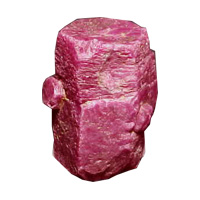Understanding Rubies
Ruby is one of the hardest natural gemstones. It belongs to the class of minerals called Corundum - second
only to diamond in its hardness. When it is any color other than red, it is called sapphire. Unlike diamond,
which is made of carbon, ruby is a combination of aluminum and oxygen.
Rubies are so rare and expensive that cutters tend to shape them into ovals or cushions instead of round
shapes (more popular in diamonds). Oval and cushion shapes preserve most of the original rough. Round rubies
are also popular, but their final shape involves removing a lot of rough and they therefore tend to be more
expensive than ovals and cushions. The following styles of ruby are the most popular:
Step Cut/Emerald Cut
Rows of facets are cut parallel to the ruby's edge resembling the steps of a staircase. When the corners
of the ruby are clipped, the shape is referred to as an 'emerald' cut. 'Emerald' cuts protect the corners
of the ruby.
Brilliant Cut
The facets on brilliant cut gems are triangular, kite or lozenge shaped. A brilliant cut ruby can have a
varying number of facets, but when cut like a diamond, it will have 58 facets. This diamond-cut will not
make the ruby "sparkle" as much as other cuts, mostly because of the difference in light refraction and
intensity of color between rubies and diamonds.
Mixed Cut
The mixed cut combines step and brilliant cut facets and
is the most common faceting style for
ruby. The crown is usually brilliant-cut to enhance sparkle. The pavilion is usually step-cut
to save weight and enhance the stone's color.
Cabochon Cut
Antique jewelry often features cabochon (Kab-a-shon) rubies, cut in a convex form (domed with a flat base)
and highly polished but not faceted. Cabochon cuts are the simplest, and are therefore the least expensive
of the ruby cuts.
Other cuts and carvings (designs cut into the ruby) also exist, but they are less popular and are not dealt
with here.





